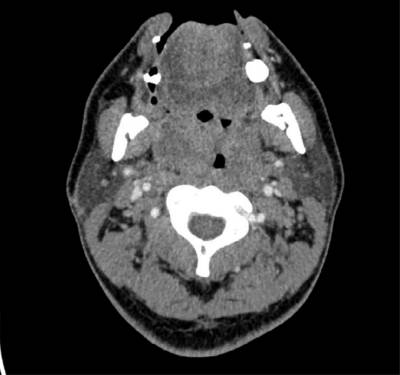CT scans important for diagnosis of throat abscesses
Different types of abscesses in the throat can cause confusion unless CT scans are performed, say doctors.
Published online 28 February 2016

Axial cut of contrasted CT showing collections of fluid within bilateral enlarged tonsils.
© QScience / J. Cheong
Physicians at the University of Malaya discuss the first known reported case of a patient with abscesses inside the tissues of both tonsils, or “bilateral intratonsillar abscesses”. Unilateral (one-sided) intratonsillar abscesses are generally rare and potentially underreported. One case study reported a 5% prevalence of unilateral intratonsillar abscesses in 149 patients who presented with abscesses in tissues surrounding the tonsil (peritonsillar abscesses). Until now, no studies had reported cases of bilateral intratonsillar abscesses. These abscesses are thought to be more common in people whose immunity is compromised.
A patient who has had diabetes for 25 years arrived at the emergency room with a fever, difficulty in breathing and swallowing, and a mild spasm in his jaw. Both tonsils were enlarged and inflamed and a tender bulge was felt below the right jaw.
The physicians’ initial diagnosis was deep neck abscess, so a CT scan was done for confirmation. This revealed bilateral intratonsillar abscesses.
“The clinical presentations of intratonsillar abscess do not differ much from that of peritonsillar abscess,” write the ear, nose and throat doctors. Accurate diagnosis is thus challenging. Peritonsillar abscesses are diagnosed by drawing pus from them with a needle. When no pus is drawn, doctors usually assume the tissue surrounding the tonsils is inflamed rather than hiding an abscess. This is called peritonsillitis and is managed conservatively. But this means intratonsillar abscesses could be missed by clinicians, the researchers write.
“We recommend that for any patient presenting with symptoms of acute tonsillitis with change in voice and trismus [jaw spasm] but who do not show the classical signs of unilateral peritonsillar abscess, a CT scan would suffice to establish a diagnosis so that timely surgical treatment can be offered to improve patient outcome,” they conclude.
The patient underwent a tonsillectomy resulting in rapid improvement. He was discharged on the third postoperative day.
Reference
- Cheong, J. P., Chong, A. W. & Mun K. S. Bilateral intratonsillar abscesses: a first case report in an adult patient. J. Emerg. Med. Trauma Acute Care 2015, 7 (2015). | article
DOI: 10.1038/qsh.2016.101

